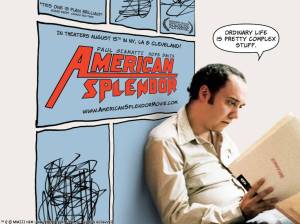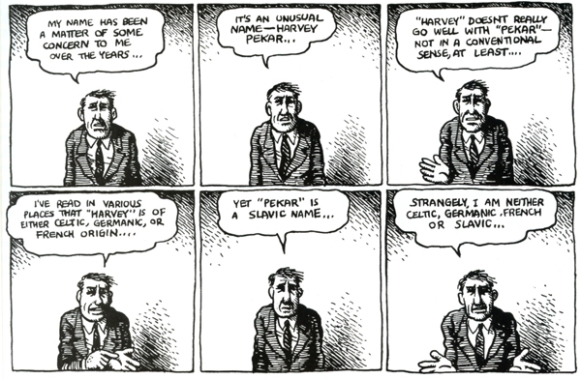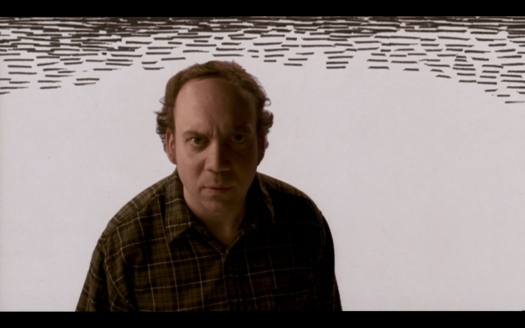1)Book Analysis: Harvey Pekar’s series of comics titled American Splendor follow Pekar’s own life in Cleveland, Ohio. Subject matter can range from his job to his bouts with cancer but, for the most part, the focus is on the negative aspects of his life. Pekar utilizes these negative chronicles in his life to twist them into a sort of dry, sardonic humor. Themes present in his comics include brutal realism, regret, and depression.
2) Film Analysis: The 2003 film American Splendor, directed by Shari Springer Berman and Robert Pulcini, is based from the comics written by Harvey Pekar of the same name. Starring Paul Giamatti as Pekar and Hope Davis as h is wife Joyce Brabner, the film functions in a similar fashion to the comics in that it serves as an autobiography of sorts and follows Pekar in his dealings with depression, writing comics, his battle with cancer, and his relationships with friends and family. Berman’s film maintains the themes of the comics and manages to draw humor from the seemingly unfortunate chain of events that make up Pekar’s life. The filming style is a mixed bag of techniques which employs documentary-like footage, animated bits, a comic panel-like effect and interviews alongside the film’s own unique narrative in order to afford the audience a glimpse at the true Harvey Pekar in juxtaposition to Berman’s adaptation. The soundtrack is largely jazz-influenced with various appearances of Motown.
is wife Joyce Brabner, the film functions in a similar fashion to the comics in that it serves as an autobiography of sorts and follows Pekar in his dealings with depression, writing comics, his battle with cancer, and his relationships with friends and family. Berman’s film maintains the themes of the comics and manages to draw humor from the seemingly unfortunate chain of events that make up Pekar’s life. The filming style is a mixed bag of techniques which employs documentary-like footage, animated bits, a comic panel-like effect and interviews alongside the film’s own unique narrative in order to afford the audience a glimpse at the true Harvey Pekar in juxtaposition to Berman’s adaptation. The soundtrack is largely jazz-influenced with various appearances of Motown.
3) Adaptation Analysis: When viewed beside its graphic novel counterpart, Shari Springer Berman’s American Splendor is unquestionably a faithful adaptation of Harvey Pekar’s works and life. While the film isn’t a word-by-word, shot-by-shot carbon-copy of the comic, it manages to keep the themes, humor, and overall spirit of the original series. The film, like the comic, focuses on the mundane issues that Pekar faces on a daily basis as a comic writer such as a troubled relationship with his wife, uncertainty regarding his commercial success. Most importantly, Berman managed to capture Pekar’s special brand of “optimistic cynicism” through the casting of Paul Giamatti who channeled the world-weary writer beautifully.
4) Online Sources
Interview with the Director of American Splendor
- An interview between IGN’s Steve Head and directors Shari Springer Berman and Rob Pulcini in which they discuss their interactions with the real Pekar, his own personal input in the film, and the reception of the film. This is a useful interview because it provides insight into Pekar. Furthermore, it clarifies important points of film, answering some essential questions.
http://www.ign.com/articles/2003/08/29/interview-with-the-directors-of-american-splendor
Style, Voice, and Authorship in Harvey Pekar’s (Auto)(Bio)Graphical Comics
- This article examines Harvey Pekar’s role as author of the “American Splendor” comics.
Bredehoft, Thomas A. “Style, Voice, And Authorship In Harvey Pekar’s (Auto)(Bio)Graphical Comics.” College Literature38.3 (2011): 97-110. Academic Search Premier. Web. 25 June 2015.
Against Hollywood
- This article examines how American Splendor and other films contribute to the American indie film movement “against Hollywood.”
http://www.haujournal.org/index.php/hau/article/viewFile/hau2.2.002/297
5) Critical Analysis
How does the film express naturalism and/or realism? And how does it compare to the way the book is naturalistic and/or realistic?
Harvey Pekar’s opening line warning the audience of their film decision does a phenomenal job of setting the tone for the rest of the movie, and its blatantly honest commentary on the “real” problems that cannot be captured in a romanticized world. American Splendor, a series written by Pekar himself, serves as an autobiography that does not waste its time trying to force-feed its audience with a feel-good narrative. This is not to say that Pekar draws the world as a place of perpetual darkness, but instead tells a tale of subtle inspiration through a man who, because of a terminal illness and a swath of social problems, must contend with the day-to-day reality that is his life. One could argue that there are no lessons to be learned and no progression for Pekar as a character but this simply lends a sense of legitimacy and genuineness to his life. The film as, well as the comic series, remains mundane in its nature and, speaking of nature, its accurate depiction of life “as we know it” down to every last detail stays true to the naturalist style employed in both mediums.


Sizana,
I agree with your analysis that American Splendor depicts “life as we know it” rather than an romanticized version of it that is prominent in books and films alike. I also think that perhaps that is one of the primary reasons why American Splendor is popular with audiences because it depicts real life situations, and Harvey Pekar, though grouchy and moody, is after all just a common joe that you can meet on the streets. The fact that he does not go through any significant development or AHA! moment in his life also adds to the “reality” and approachability of the comics and the film.
LikeLike